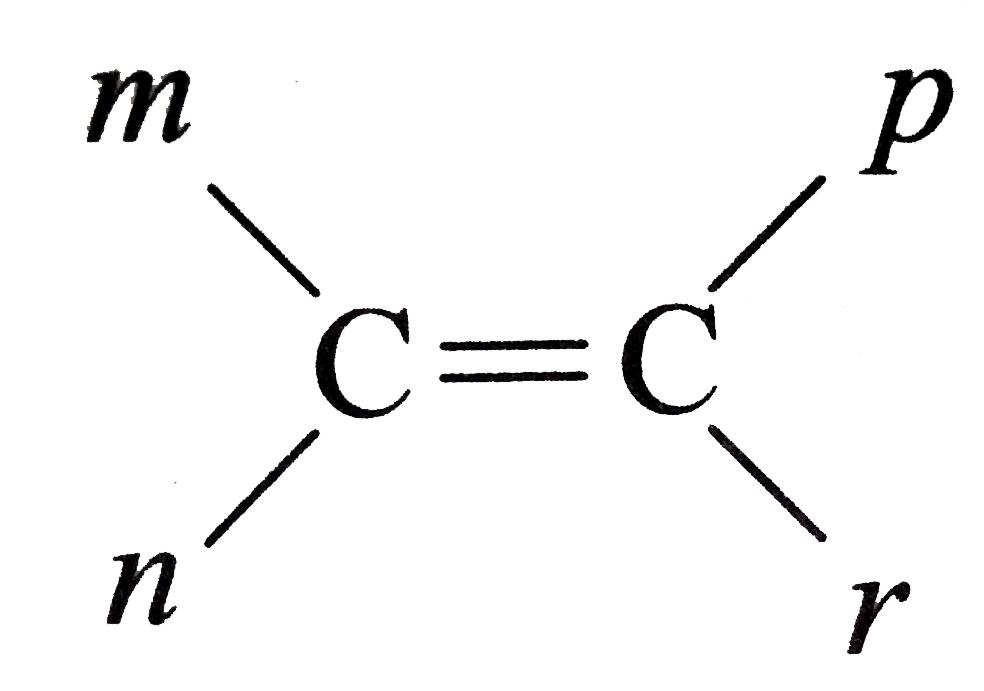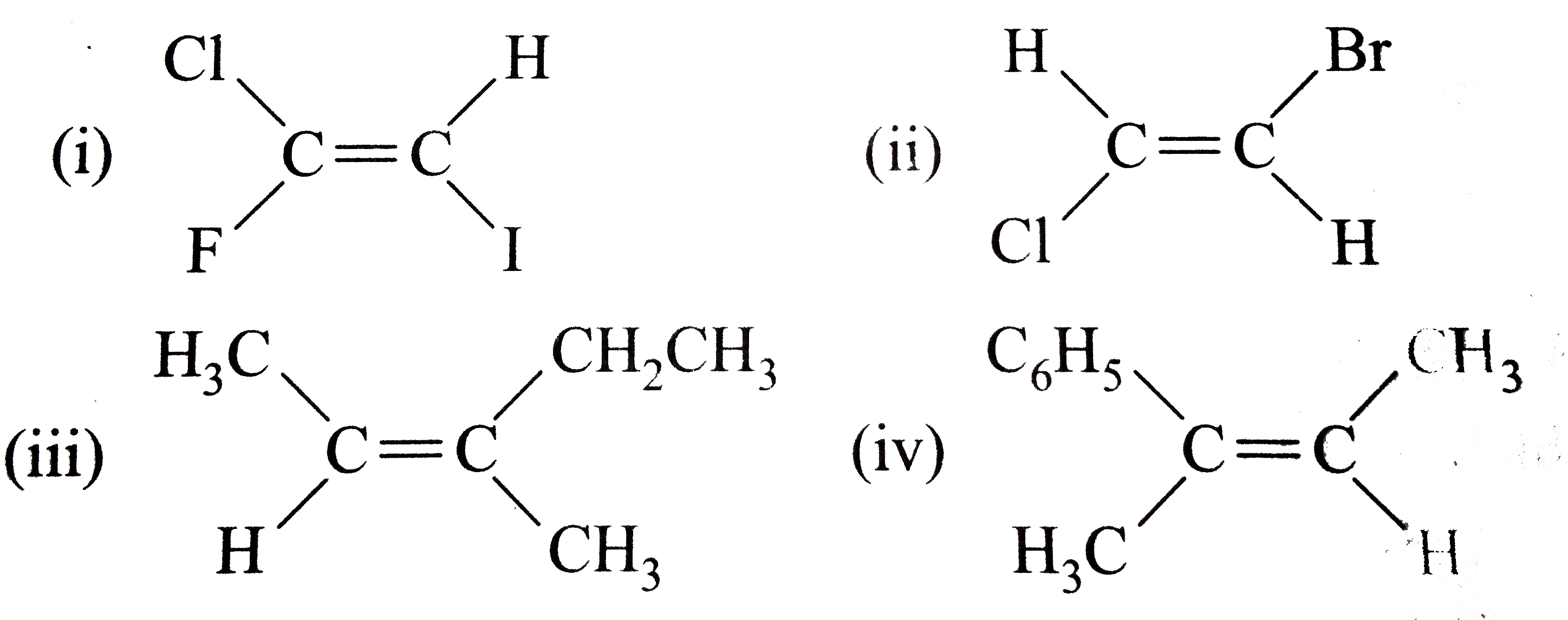Complete Solutions to Example of chapter ALKENES of Class 11 book with complete answers and questions
| Class 11 | CHEMISTRY |
| Chapter | ALKENES |
| R SHARMA | Example |
| Number Of Questions | 9 |
| Academic Year | 2023-24 |
Work out all possible structural isomeric alkenes corresponding to `C_(5)H_(10)` and also give their `IUPAC` names.
Strategy: Alkene isomers are deduced by writing the different `C` skeletons and then introducing the double bond at different locations. The possible skeletons are
`C-C-underset((I))C-C-C,C-underset((II))underset(C)underset(|)C-C-C,C-underset((III))underset(C )underset(|)overset(C )overset(|)C-C`
View SolutionWhile of the following compounds will exhibit geometrical (or cis-trans) isomerism?
(i) `CH_(3)CH=CHCH_(2)CH_(3)`
(ii) `C_(6)H_(5)CH=CHCH_(3)`
(iii) `CH_(2)=C(CH_(3))_(2)`
`(CH_(3))_(2)C=CH-C_(2)H_(5)`
Strategy: Essential requirement for any alkene to exhibit geometrical isomerism is that each of the double bonded carbon atoms should be attached to two different atoms or groups of atoms:

`m!=n and p!=r`. Notice that `m` and `p` may be same or different Similarly, `n and r` may be same or different.
View SolutionDraw geometrical (or cis-and trans-) isomers of the following structures and give their `IUPAC` names.
(i) `C_(2)H_(5)C CH_(3)=C CH_(3)C_(2)H_(5)`
(ii) `CH_(3)CH_(2)CH=CHCH_(2)CH_(3)`
Strategy: An isomer in which two identical atoms (or groups) lie on the same sides of the double bond is called as cis isomer whereas an isomers in which identical atoms ( or groups) lie on the opposite sides of the double bond is called a trans isomer.
View SolutionClassify the following alkenes and their derivatives as `Z or E`
(i)
(ii)
Strategy: This method is preferable to the use of cis-trans beacuse it is not practical to identify cis and trans isomers when the four groups on `C=C` are different. The letter `Z` is used when the two high-priority substituets are on the same side of the double bond and the letter `E` is used when they are on the opposite sides (from the German words zusammen meaning together and entgegen meaning opposite), as shown:
View SolutionUsing Markovnikov's rule, correctly predict the principal product of the following reactions:
(i) `"But-1-ene"+HIrarr`
(ii) `"Vinyl chloride"+HIrarr`
(iii) `But-2-"ene"+HIrarr`
(iv) `2-"Methylbut-2-ene"+HIrarr`
(v) `"Pent-2-ene"+HIrarr`
Strategy: Use Markovnikov's rule for unsymmetrical alkenes: Positive part of the addendum ( adding molecule, `HI`) gets attached to that doubly bonded carbon atom which possesses more number of hydrogen atoms:
View SolutionFind the products obtained by the addition of `HBr` "to hex`-1-ene`"
(i) in the presence of preoxide
(ii) in the absence of peroxide
Also write their `IUPAC` names.
(i) Strategy: In the presence of peroxides, the particle that attacks the double bond first is the large bromine atom. It attaches itself to the less hindered carbon atom to form a more stable free radical. The result is anti-Markovnikov's addition.
(ii) Strategy: In the absence of peroxides, the particle that attacks the double bond first is a proton ( beacuse a proton is small, steric effect are not important). It attaches itself to a carbon atom by an ionic mechanism to form the most stable carbocation. The result is Markovnikov's addition.
View SolutionIn one industrial synthesis of ethanol, ethane is first dissolved in `95%` sulphuric acid. In the second step, water is added and the mixture is heated. Outline the reaction involved.
Strategy: Alkyl hydrogen sulphates are easily hydrolyzed to alcohols by heating with water.
View SolutionAn unknown alkene of molecular formula `C_(8)H_(16)` on oxidation with hot alkakline `KMnO_(4)` yields propanoic acid and pentanoic acid. Find the structure of the alkene.
Strategy:
`C_(8)H_(16)underset((2)H_(3)O^(+))overset((1)KMnO_(4)`,H_(2)O,OH^(-)"heat")rarrCH_(3)CH_(2)-underset("acid")underset("Pentanoic")overset(O)overset(||)C-OH+HO-underset("acid")underset("Pentanoic")overset(O)overset(||)C-CH_(2)CH_(2)CH_(2)CH_(3)`
Remove the `OH` groups and join the carboxylic acid carbons by a double bond to get the alkene.
View SolutionAn known alkene with formula `C_(7)H_(12)` on oxidation with hot alkaline `KMnO_(4)` yields only the following product
`CH_(3)-overset(O)overset(||)C-CH_(2)CH_(2)CH_(2)CH_(2)-overset(O)overset(||)C-OH`
What is the structure of this alkene?
Strategy:
`C_(7)H_(12)underset((2)H_(3)O^(+))overset((1)KMnO_(4),H_(2)O,Ooverset(-)H)rarrCH_(3)overset(O)overset(||)C CH_(2)CH_(2)CH_(2)CH_(2)overset(O)overset(||)C-OH`
Since the oxidation cleavage leads to just one product which contains the same number of carbon atoms as the reactant, the unknown alkene must have a double bond contained in a ring. The oxidative cleavage of the double bond result in the opening of the ring. To create the ring, remove the -`OH` group and doubly bonded `O's` and finally join the carboxylic acid carbon with ketone carbon by a double bond.
View Solution
Example questions and complete solutions for chapter ALKENES of R SHARMA CHEMISTRY (HINGLISH) of Class 11